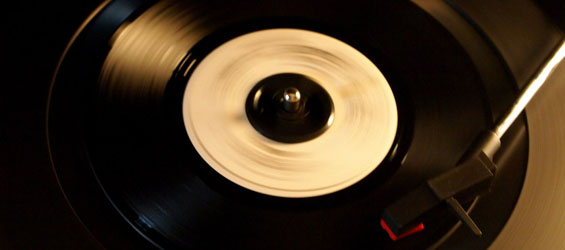Vinyl Will Never Die
 In stark comparison to the warm sunny day, inside it is dim and musty. As you look around, you notice hints of an earlier, simpler time: racks of miniskirts, bell-bottom jeans and everything you could need to complete the androgynous hippie look; the walls lined with framed pin-up dolls from the 70’s, and eclectic knick-knacks and toys from the 60’s. Off to the right of the room is a man, napping in a wheelchair, hooked up to an IV. Past him are long rows of crates and boxes that seemingly go on forever. And what’s that up above? Engulfing the room is the warm sound of classic rock that is played on a vinyl record. This can only be one place…a record store.
In stark comparison to the warm sunny day, inside it is dim and musty. As you look around, you notice hints of an earlier, simpler time: racks of miniskirts, bell-bottom jeans and everything you could need to complete the androgynous hippie look; the walls lined with framed pin-up dolls from the 70’s, and eclectic knick-knacks and toys from the 60’s. Off to the right of the room is a man, napping in a wheelchair, hooked up to an IV. Past him are long rows of crates and boxes that seemingly go on forever. And what’s that up above? Engulfing the room is the warm sound of classic rock that is played on a vinyl record. This can only be one place…a record store.
What comes to mind when you hear these two words: Vinyl records ? Maybe you think of music, rock ‘n’ roll or possibly even hippies? What about archaic, outdated or obsolete? Any of these answers would be correct. In fact, vinyl records reached their peak of popularity in the 1950’s. According to a 1958 article from The New York Times LP records accounted for 58% of all music sales and 45 records - oriented toward the single song - accounted for another 40% of all music sales. From the age of Rock ‘n’ Roll to the late 80’s, Vinyl records continued to be the most popular way to listen to music until Compact Discs (CDs) became popular and the progress of digital music took over.
The success of the turntable (and vinyl records in general) is dependent on the ability to mass produce these records. This process has deep roots in Thomas Edison’s phonograph. According to HowStuffWorks, a subsidiary of Discovery Communications, the process begins with the creation of a master recording. This is usually done in a studio where engineers perfect the recorded sound. Vinyl records require an analog recording while newer technology, like CDs, are digital.
After obtaining a master copy of the recording, it is cut into a metal disc which is used to form the stamper, a negative version of the original recording that will be used to make the record. From there, the stamper is placed in a hydraulic press, and steam softens the plastic as an impression of the master recording is formed. To finalize the process, cool water is used to harden the plastic. Once the vinyl is pressed, it is packaged and shipped to record stores all over the world. However, these records need a proper machine to bring their sounds to life—the turntable. The turntable produces sounds by dragging a needle over a turning record, creating vibrations that are amplified by speakers.
Doc’s is one of the handful of record stores that remain in Fort Worth, Texas. When I walk in, a man in the wheelchair looks up for a moment to say “Hey…I’m Jenkins…let me know if you need anything” and slowly sinks back into the peculiar scene. He’s young, maybe in his early to mid-twenties and looks like one of the Blues Brothers, down to the fedora and R ay B ans. There is nothing better than a John Belushi look-a-like owning and running a record store.
Jenkins Boyd – Doc’s founder and owner – decided to forgo college and pursue a lifelong goal to start a business with his father. Jenkins, 25-years-old, has been a record enthusiast since childhood, introduced to vinyl by his father. It was through his relationship with his father and their mutual love for vinyl that this store was born. Jenkins and his father, Jon “Doc” Boyd, opened Doc’s Records and Vintage in 2006, and is one of the few vinyl sellers in Fort Worth.
So what is the best part of the vinyl business? “Digging. No question,” said Jenkins. Whether it’s watching customers spend hours looking through the vinyl or meeting up with a few friends at a local garage sale. “It’s what makes vinyl so exciting.” Ah, digging: it’s the ideal treasure hunt. I love spending hours searching for that perfect record. The hardest part is where to begin? It’s best just to jump in, any crate will do. Flip, flip, flip, you go through one-by-one. Each quick movement of the fingers kicks up more of the sweet aroma of the paper jackets that encase the vinyl. The surroundings start to melt away and the chase is on; all that matters is keeping your eyes on the prize. Eyes dart from one cover to the next, your heart starts pumping faster and faster. And then, just when you can’t take any more, there it is: the record you have been searching for.
A primary difference between "shopping" and "digging" for records is that you don’t go in knowing what you’re looking for. So you dig, finding interesting things as you go, most of which you may have never heard of, spending hours listening to and screening them all (most record stores have a record player available to customers for previewing purposes), before deciding what is worthy of a purchase.
When asked what types of people shop at Doc’s, Jenkins simply said he gets all kinds of people buying his records, from serious collectors to casual listeners. “There isn’t a specific age range for these people. Yeah, sure we have a lot of older, retired guys who dig for records as a hobby. But then we’ll have a bunch of younger kids in their twenties or so who will spend all day here.”
As I started to do some digging of my own, I noticed a woman in her early twenties, wearing skinny jeans and a cardigan, going through a stack of the new releases. Lizzy Caudill is a regular at Doc’s. To her, the difference between vinyl and digitized music is like “comparing a formal dinner to fast food.”
“I feel like listening to a vinyl is so much more intimate than listening to an MP3 or iPod. Digital music is something that everyone around the world has access to and can own in less than a minute,” says Caudill. “But a vinyl record takes time, appreciation, and when I’m listening to it I feel a much larger connection with the music and band. The only downside is that I can’t take the raw sound from my record player with me while I’m on the go, but it’s worth the wait to come home at the end of the day and put on my favorite records.”
How do vinyl records fit into today’s rigid and technology -obsessed culture? These same records which require a turntable to listen to, records that seem so obsolete in society today, are they actually looking to make a comeback? Yes, newer technology, like the Apple iPod, can put thousands of songs in your pocket, but vinyl is a growing niche for a number of music lovers. For them, there’s nothing like a real groove.
Vinyl records are just about everywhere. From the stages of the big-named deejays to the small studio apartment of a hipster, the “outdated” vinyl record is still very present in our society today. For instance, today we see many record labels re-releasing vinyl LPs. In addition, many of today’s artists are putting their work on vinyl including Lady Gaga, Eminem and many others. The manufacturers of vinyl records say sales are up enough to keep them in the black. And Amazon.com, a completely internet-based company, has even integrated a vinyl-only website into their repertoire.
Vinyl is still very much a niche market. That being said, it has slowly grown beyond its initial small footprint of deejays, die-hard collectors and other aficionados, and will continue to hold steady. According to the latest data from Nielsen Soundscan, vinyl sales in the U.S topped $3.9 million in 2011, a 39.3 percent gain over 2010. The music industry has seen this trend increase since 2007 and market analysts believe it should continue to grow. Part of the resurgence of the popularity of vinyl records is coming from the “retro-cool” of a nostalgia for the simpler world of the vinyl record. Though perceptible and personal factors such as larger space available for artwork and lyrics, and others which offer a great deal of tangible satisfaction and play a large role in this revival.
Listening to music on a vinyl record is easily one of the best things to help you wind down at the end of a long day. Cracking open a beer and sinking into the couch while enjoying the new record you spent all day looking for is the greatest feeling—hearing the needle hitting the groove etched into the pressed vinyl, the slight crackle that emits from the speaker—this can’t be anything but the warm sounds of vinyl. Each pop holds you on the edge of your seat until their warm harmony finally reaches your ears, filling and swirling around you – engulfing you completely. It’s the only way to really experience music.
So why will vinyl never die? While records may not be in their hay-day, vinyl records have always had a strong following. Caudill believes in a more sentimental and emotional calling when it comes to collecting and experiencing vinyl records. “There will always people that are passionate about music, so passionate that they will want to listen to it in the most organic way possible- through vinyl.” And Jenkins, when asked the same question, responded heartily. The only way vinyl will ever die is “maybe if a comet hits the earth.” he says with a laugh, “but besides that people will always collect records. People collect crap, you know? So there are always going to be record collectors.”
